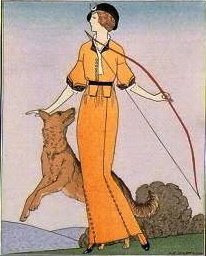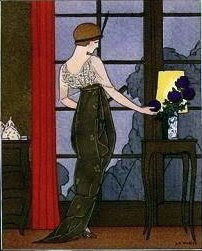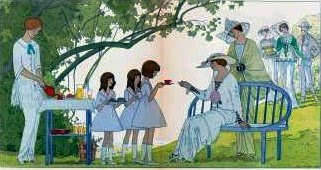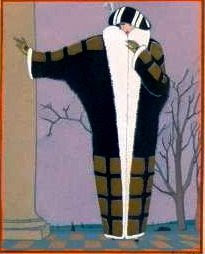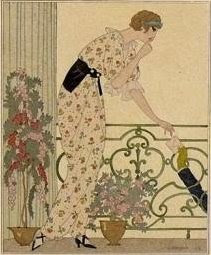GAZETTE DU BON TON,PUBLISHED BY LUCIEN VOGEL, 1912-1928.
DESIGNED AS A JOURNAL TO APPEAL TO THE ELTE OF PARIS, FULL OF HIGH FASHION PLATES AND CHATTY ARTICLES ON ALL ASPECTS OF LIFE FOR THE PRIVILED, IT TRANSCENDS ITS MUNDANE GOALS THROUGH THE INCREDIBLE QUALITY OF THE PUBLICATION FROM THE HIGH QUALITY PAPER TO THE BREATH TAKING BEAUTY OF THE PRINTS AND THE HIGH QUALITY OF THE ART THROUGHOUT.
THE EXTRAVAGANTLY VIVID COLORS OF THE PRINTS WERE CREATED BY THE POCHOIR PROCESS, WHEREIN SINGLE LAYERS OF COLOR WERE ADDED BY HAND TO A LITHOGRAPH USING A STENCIO, IN A PRECURSOR OF THE SILK SCREENING TECHNIQUE WHICH IS NOW WIDELY USED FOR ART PRINTS.
Friday, December 5, 2008
MARTY
Andre Edouard Marty or A.E. Marty (April 16, 1882-August 1974) was a Parisian artist who worked mainly in the classic Art Deco style.
A.E. Marty studied at the ?cole des Beaux-Arts and Atelier Fernand Cormon in Montmartre, Paris. He was appointed on the jury for the 1925 Exposition Internationale des Arts D?coratifs et Industriels Modernes, from which the Art Deco movement took its name.
Marty was one of only four artists to contribute to every year of La Gazette du bon ton a leading pochoir fashion magazine in Paris and in Europe (1912 to 1925).
Marty also had illustrations published in Vogue, Harper's Bazaar, Vanity Fair, House & Garden, Le Sourire, F?mina, Modes et Mani?res d?Aujord?hui and Comoedia Illustre, among others.
He also illustrated numerous books and designed advertisements and theatre posters (including a number of famous ones for the Ballets Russes and the Th??tre National de l'Op?ra in 1910).
In the 1930s Marty worked as a costume and set designer for the theatre, cinema and ballet. Later he also produced designs for enamel vases, plates and jewellery.
A.E. Marty studied at the ?cole des Beaux-Arts and Atelier Fernand Cormon in Montmartre, Paris. He was appointed on the jury for the 1925 Exposition Internationale des Arts D?coratifs et Industriels Modernes, from which the Art Deco movement took its name.
Marty was one of only four artists to contribute to every year of La Gazette du bon ton a leading pochoir fashion magazine in Paris and in Europe (1912 to 1925).
Marty also had illustrations published in Vogue, Harper's Bazaar, Vanity Fair, House & Garden, Le Sourire, F?mina, Modes et Mani?res d?Aujord?hui and Comoedia Illustre, among others.
He also illustrated numerous books and designed advertisements and theatre posters (including a number of famous ones for the Ballets Russes and the Th??tre National de l'Op?ra in 1910).
In the 1930s Marty worked as a costume and set designer for the theatre, cinema and ballet. Later he also produced designs for enamel vases, plates and jewellery.
Wednesday, December 3, 2008
LEPAPE
Georges Lepape, studied at the Ecole des Arts D?coratifs, Paris, and the ateliers of Humbert and Cormon. In 1911 illustrated Les Choses de Paul Poiret and the following year programmes for the Ballet Russe . Innumerable magazines covers and fashion plates for La Gazette du Bon Ton and Vogue.
In 1911, Poiret again published a brochure of his designs, this time created by another young artist, Georges Lepape, who had been trained in the atelier run by Fernand Cormon, where Toulouse-Lautrec, Van Gogh, S?rusier, Matisse, and Picabia had all studied. Les Choses de Paul Poiret, vues par Georges Lepape appeared in a larger edition: one thousand copies were printed (Paris: 1911). Lepape, too, had absorbed the lessons of bright color taught by the Ballet Russes, and his pochoir prints of Poiret's still high-waisted fashions in this brochure and later in the Gazette du Bon Ton used line drawings with large areas of blues, greens, reds, pinks, and yellows.
In 1911, Poiret again published a brochure of his designs, this time created by another young artist, Georges Lepape, who had been trained in the atelier run by Fernand Cormon, where Toulouse-Lautrec, Van Gogh, S?rusier, Matisse, and Picabia had all studied. Les Choses de Paul Poiret, vues par Georges Lepape appeared in a larger edition: one thousand copies were printed (Paris: 1911). Lepape, too, had absorbed the lessons of bright color taught by the Ballet Russes, and his pochoir prints of Poiret's still high-waisted fashions in this brochure and later in the Gazette du Bon Ton used line drawings with large areas of blues, greens, reds, pinks, and yellows.
BARBIER
George Barbier (1882 - 1932) was one of the great French illustrators of the early 20th century. Born in Nantes France on October 10, 1882, Barbier was 29 years old when he mounted his first exhibition in 1911 and was subsequently swept to the forefront of his profession with commissions to design theatre and ballet costumes, to illustrate books, and to produce haute couture fashion illustrations.
For the next 20 years Barbier led a group from the Ecole des Beaux Arts who were nicknamed by Vogue as "The Knights of the Bracelet" - a tribute to their fashionable and flamboyant mannerisms and style of dress. Included in this ?lite circle were Bernard Boutet de Monvel, Pierre Brissaud, Paul Iribe, Georges Lepape and Charles Martin. During his career Barbier also turned his hand to jewellery, glass and wallpaper design, wrote essays and many articles for the prestigious Gazette du bon ton.
In the mid 1920s he worked with Ert? to design sets and costumes for the Folies Berg?re and in 1929 he wrote the introduction for Ert?'s acclaimed exhibition and achieved mainstream popularity through his regular appearances in L'Illustration magazine.
Barbier died in 1932 at the very pinnacle of his success.
For the next 20 years Barbier led a group from the Ecole des Beaux Arts who were nicknamed by Vogue as "The Knights of the Bracelet" - a tribute to their fashionable and flamboyant mannerisms and style of dress. Included in this ?lite circle were Bernard Boutet de Monvel, Pierre Brissaud, Paul Iribe, Georges Lepape and Charles Martin. During his career Barbier also turned his hand to jewellery, glass and wallpaper design, wrote essays and many articles for the prestigious Gazette du bon ton.
In the mid 1920s he worked with Ert? to design sets and costumes for the Folies Berg?re and in 1929 he wrote the introduction for Ert?'s acclaimed exhibition and achieved mainstream popularity through his regular appearances in L'Illustration magazine.
Barbier died in 1932 at the very pinnacle of his success.
Subscribe to:
Posts (Atom)







